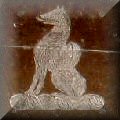|
|
|
Ballyseedy Castle
Ballyseedy, near Tralee, Co.Kerry
first named "Elm Grove", until a remodelling completed in 1821...
then known as "Ballyseedy House", until a remodelling during the 1880s...
then known as "Ballyseedy Castle" until sold out of the Blennerhassett family in 1967...
now "Ballyseede Castle Hotel"
|
|
|
|
Ballyseedy is pronounced "Ballysheedy" (Bail ó Sioda = O'Sheedy's Town).
Ballyseedy townland is a small part of the larger Ballyseedy civil parish, which is the same as Ballyseedy Church of Ireland parish.
|
|
|
|
|
|
|
|
Ballyseedy - view of what is now the front of house, from a postcard of c2000 |
|
|
|
click on image to enlarge
|
|
|
|
|
"The Seat of Arthur Blennerhassett Esq MP Co.Kerry"
Ballyseedy c1837-1841
view of what was then the front of the house but is now the rear,
i.e. before reversal of the main entrance in the 1880s
Detail from a watercolour of c1837-1841, artist unknown, private collection.
from a photograph of the watercolour in the archives at Glin Castle
image used courtesy of the late Desmond FitzGerald, Knight of Glin (R.I.P.)
The adjoining townlands of Ballycarty and Ballyseedy were the focal point of the Blennerhassett estate in Co.Kerry and the principal seat of the Blennerhassett family from 1590 to 1967. Ballycarty and Balllyseedy each contained small but ancient Geraldine forts or castles that belonging to the family of FitzGerald, Earl of Desmond, before the FitsGeralds were dispossessed for rebelling against Elizabeth I.
Ballyseedy and Ballycarty were among lands granted in <???> to the planter Sir Edward Denny by Queen Elizabeth, as part of the creation of the Plantation of Munster. They were subsequently a part of lands granted by Sir Edward Denny to Thomas Blennerhassett of Cumberland, England in 1590.
The Blennerhassett family settled at Ballycarty during the early 17th century and later occupied Ballyseedy also. In 1721 they built the first "Ballyseedy House", among ruins of the geraldine Ballyseedy Castle at the west end of Ballytseedy Wood. This was occupied up to his death in 1775 by "The Great Colonel John" Blennerhassett (1691-1775).
The present "Ballyseedy House" (since c1969 known as "Ballyseede Castle Hotel") was built c1780 as a new house named "Elm Grove" by the Colonel's younger brother William Blennerhassett Sr (1705-1785). The work was completed c1788 by his son William Blennerhassett Jr. (c1735-1797), a substantial late 18th century country house situated on the south bank of the River Lee, within both Ballyseedy townland and Ballyseedy parish, close to the boundary between Ballyseedy and Ballycarty townlands.
The house was rebuilt and enlarged twice, firstly in 1821, the name "Elm Grove" being discarded at this date, the name reverting to "Ballyseedy" because the original old "Ballyseedy" at the west end of Ballyseedy Wood had by then fallen into disrepair and disuse. During this first remodelling (completed 1821) the north wing was added. In the north wing is a "Banqueting Hall" which features a foundation stone dated 1721, set into the wall over primitive 17th century black oak fireplace surround. The fireplace surround in the banqueting hall, also another 17th century wooden fireplace surround of finer workmanship that was installed in what was the library (now the hotel bar) of the main house, are believed to have been moved with other free-standing oak furniture from "Old" Ballyseedy" as it fell into ruin.
It was William Blennerhassett Jr's son Arthur (1779-1815) and his wife Dorcas Twiss (1775/7-1822) who commenced addition of the long north wing, something of a "folly" with the stable yard surrounded by a great wall of false windows, with two carriage entrances and a round tower of medieval appearance at the north-west corner. The work of architect Sir William Morrison, this remodelling was completed in 1821, exactly 100 years after the older "Ballyseedy House" house had been built, by his son Arthur Blennerhassett (b.1799 d.1843) then only 22 years of age. 1821 was also the year of this Arthur's marriage to Frances Grady (b.c1800 d.1834).
As mentioned above, at the 1821 remodeling the house name "Elm Grove" was changed to "Ballyseedy", the traditional name being transferred from the older family home (a mile away, at the western end of Ballyseedy townland and the western end of Ballyseedy wood, close to what had formerly been the village of Ballyseedy). I have not seen the name Elm Grove (a.k.a. Elmgrove) in any document or newspaper dated later than 1819. "Old" Ballyseedy was one of the seats of the family from the mid 17th century up to the time of "The Great Colonel John". The ruins of two and perhaps three generations of "Ballyseedy" may still be seen, a short distance inside the present western edge of Ballyseedy Wood, the wood having been cleared of undergrowth, paths laid and opened to the public as a woodland park c2006. Necessary, no doubt, for public access but was far more atmospheric in 2004 before this clearance work was done. NOTE: some sources will tell you Elm Grove was a different house, burned down at the end of the 18th century, but that is not so.
During the 1880s Arthur's grandson, Maj. Arthur Blennerhassett (b.1856 d.1939), commissioned a "mock castle" refacing of the house, as was popular during the late Victorian period, these changes causing what had previously been the front elevation and west facing main entrance to become the rear of the house. A square tower (with unusual and seemingly meaningless coat of arms) was added on the east side of the long north wing, now the new "front" of the house. This work, executed by Kerry architect, historian and Blennerhassett descendant James Franklin Fuller, caused the house to lose its Georgian elegance and simplicity but resulted in the more impressive building we see today. Following these changes the house began to be referred to as "Ballyseedy Castle" and is named as such on the family headed writing paper of the time.
The watercolour illustrated here shows the house as it was between the alterations of 1821 and those of the 1880s.
The last of the family to reside at Ballyseedy Castle was Hilda Blennerhassett (b.1884 d.1965). Following her death the house, and what remained of the estate, was in 1967 sold out of the family, to become "Ballyseede Castle" Hotel. An auction of house contents, "objets d'art, furniture, antique silver, china, etc", was held at the house in June 1967. The Ballyseedy Castle Contents Auction Catalogue of 1967 includes a number of pieces of Elizabethan and Jacobean oak furniture which will, in all probability, have come from "old" Ballyseedy. Where these are now, I wonder?
|
|
|
|
|





